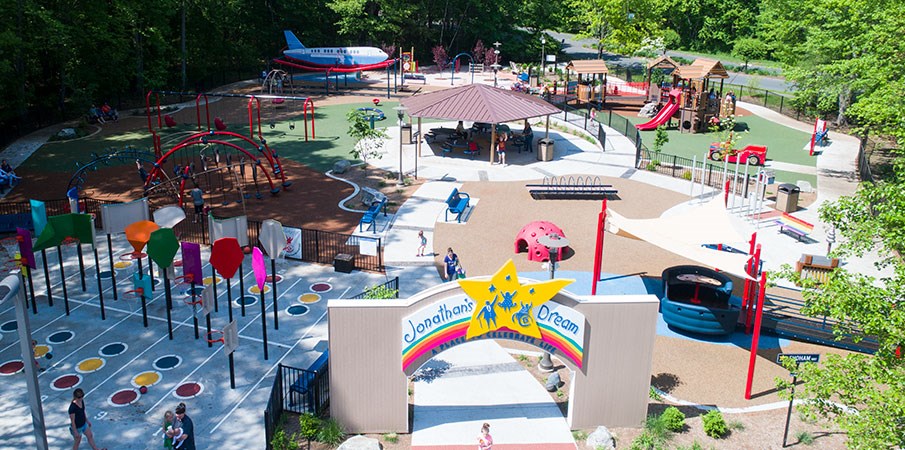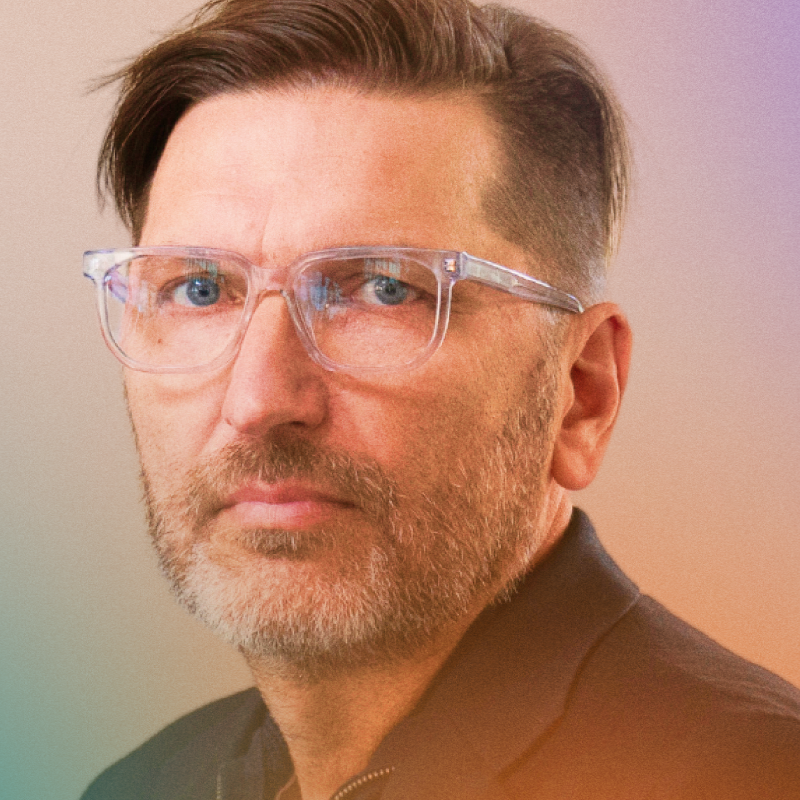In West Hartford, Connecticut, the Jonathan’s Dream playground is accessible for all families and children, those with and without disabilities alike. Kids play basketball with hoops of varying heights, suitable for those in and out of wheelchairs. Swings with torso support enable those with limited upper body strength or mobility to enjoy the classic back-and-forth fun that other kids find easily at typical neighborhood playgrounds. And, instruments and reading exhibits built into the playground foster inclusive play, where every child is welcomed and benefits physically, socially and emotionally.
Amy and Peter Barzach, the creators of Jonathan’s Dream, conceived of the playground in 1996 in honor of their son, and they later founded Boundless Playgrounds to make inclusive, accessible spaces for children more commonplace.
Jonathan’s Dream sets an example for everyone looking to create inclusive products, including those building for web accessibility. The playground teaches us that accessibility is more than simply meeting standards; accessibility is inclusive by design; it’s built-in by those who benefit; and it means continuous, ongoing improvement.
Accessibility is more than meeting standards
A quick web search on accessibility surfaces many articles and forums on how-to-not-be-sued when building for offline or online accessibility. There are hundreds of articles on meeting accessibility requirements for buildings based on the American Disabilities Act, and there are hundreds more articles and forums for web developers on what they need to do to meet W3C guidelines based on the Web Accessibility Initiative. Standards are critically important. And also, it’s important to keep in mind that standards are in place because of the humans that benefit from them. Meeting them might mean that you’re providing the best experience possible for the end-user of your product, but it might not. Maybe there’s more to be done.
Jonathan’s Dream shows us that accessibility can and should mean more than meeting standards. The playground humanizes the reason standards exist in the first place. Accessibility means giving every person a realized fair and equal opportunity.
“Each and every person — regardless of their abilities or disabilities — has a responsibility to contribute what they can to society, and each person has something unique and invaluable to give,” said James Teh, who manages accessibility for Firefox products. “But to do that, they need the tools that provide them that opportunity. In enabling people with disabilities, we enable and empower them to do their part in ensuring a brighter future for everyone.”
Accessibility is inclusive by design
According to the World Health Organization, about 15% of the world’s population lives with some form of disability. And, people with disabilities live with, and among, people without disabilities. Jonathan’s Dream doesn’t cater solely to people with disabilities, with this in mind. Instead, the playground caters to all children who want to play, socialize, learn and exert some energy. The technical term for this type of build is inclusive design, something Firefox engineers think critically about with each update of Firefox.
For example, Firefox’s Reader Mode and Narrate tools are useful for anyone who wants to focus on content or have their browser read aloud. (Anecdotally, many Firefox users use Narrate to intentionally reduce screen time.) Yet, we hear of users with many different needs who benefit from these two offerings.
People with dyslexia and cognitive disabilities who find lots of screen clutter problematic tell us they enjoy Reader Mode and Narrate. And, Narrate is advantageous for those with visual impairment. The tools also help people who are temporarily unable to carry out online tasks. When driving, for example, a person can’t use their eyes or hands to perform other tasks, like read or scroll through an online article, and Narrate is a solution for this. Both Reader Mode and Narrate are products of inclusive design: they help everyone whether they have a disability or not, permanent or temporary.
Accessibility is built-in by those who benefit
Amy Barzach, upon founding Boundless Playgrounds, used legos, string, sticks and clay to lead groups of children with and without disabilities in brainstorming what the best possible, inclusive playgrounds could look like for optimal learning, socialization, and fun. She gave the kids a Mr. Potato Head scooter so that they could think about ways children in wheelchairs could play. Playground engineers then brought the children’s dreams to life.
Accessibility is most realized when it’s built-in by design by those who benefit from it. Here at Mozilla, there are two blind engineers on the Firefox accessibility team. They provide leadership and feedback on all Firefox products, and while all product features benefit from their expertise, Firefox’s exceptional support of blind screen reader users is largely due to their input. We also have a user research group that recently conducted a study with blind and vision impaired users on how they browse in mobile Firefox products, and results are leading to more accessibility insights and product advancements.
Mozilla’s mission is to ensure the web remains a global resource, open and accessible to all. There is no better way for us to improve the accessibility part of our mission than in a way that is also inclusive and involves the people that are directly impacted by our product decisions.
Accessibility is ongoing improvement
Harsh winters and weather took a toll on Jonathan’s Dream after 16 years of initial use, and it closed in 2012 due to safety concerns. With community support, it re-opened in 2017 with a modernized and reimagined inclusive design. It features equipment inviting children to be physically engaged regardless of their abilities in the areas of strength, endurance and flexibility.
Ongoing accessibility improvement and iteration – learning from both successes and failures – is critical, as the restoration of Jonathan’s Dream illustrates. Along these same lines, Firefox is launching a significant end-user change with its update later this month: the Firefox desktop browser toolbar will be fully keyboard accessible. Users will be able to access everything, including extension buttons, right from the keyboard. Developers can expect improved keyboard and screen reader accessibility in Firefox’s Dev Tools platform as well: color contrast information will be available in the sidebar (which encourages developers to make visually accessible content), and the tree view in the Dev Tools console will also be keyboard accessible.
Online, web developers are the people on the front lines, designing for accessibility. They’re the ones responsible for ongoing improvement, and there’s a bunch of work happening in this space. Firefox Accessibility Dev Tools are being actively developed (to help all developers make accessible content, no matter what browser or platform they’re building for). Microsoft and Google are also investing significantly in accessibility. Competition among Firefox and Big Tech players to make the web more accessible is healthy, and ultimately beneficial for all users of our largest shared resource.
Accessibility is for all
Playgrounds are paramount to childhood fun, interaction, learning and development. They foster the physical, mental, intellectual and social well-being of our next generation. Jonathan’s Dream is among the most admirable examples of a playground that is truly accessible — designed for all.
Meanwhile online, the internet is the most powerful communication and collaboration resource we have ever seen — for children and adults alike. It embodies some of our deepest hopes for human progress and enables opportunities for learning, a sense of shared humanity, and a global forum to come together to address pressing problems facing people everywhere. It has the potential to level the playing field for all people with access to education and employment, improving their quality of life.
Here at Mozilla, we’re committed to making Firefox products in accordance to Mozilla’s Manifesto principles, including this one: “We are committed to an internet that includes all the peoples of the earth — where a person’s demographic characteristics do not determine their online access, opportunities, or quality of experience.”
And at Jonathan’s Dream, community volunteer Ronit Shoham says that accessibility should never be an afterthought. “Accessibility benefits everyone,” she said. “And, if accessibility were to be a first thought rather than a last thought, we’d see more connection in our world today. We’d see more places where people of all abilities could celebrate life together.”
Let’s all continue to strive for better, and not leave anyone behind. Let’s build products — from playgrounds to the web and everything in-between — as inclusive by design, with ongoing, unending improvements, hand-in-hand in partnership with the people these products ultimately serve.



